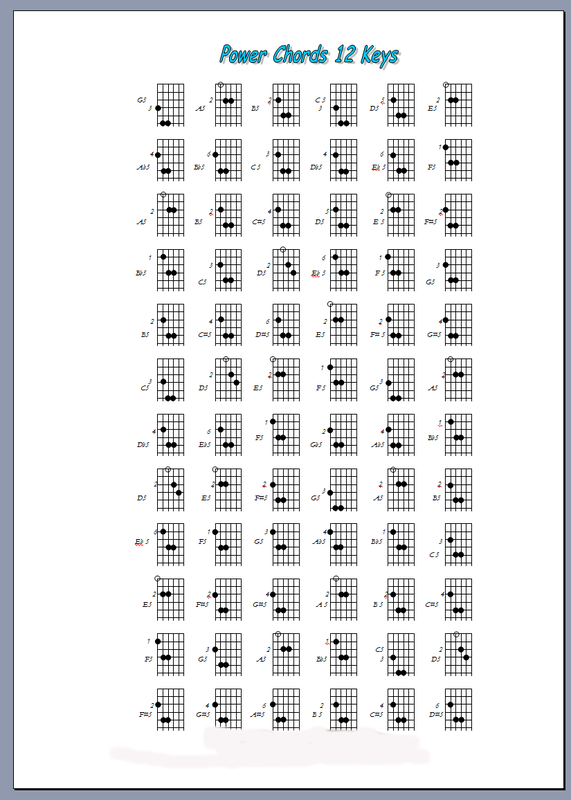Printable Version of Topic
Click here to view this topic in its original format
GMC Forum _ PRACTICE ROOM _ Power Chords
Posted by: coolzx Jan 2 2009, 01:30 AM
Hi, i've been around the site and I couldnt find any power and barre chords chart, so I was just wondering if anyone that has one plz post it here please. Thank You.
Posted by: skennington Jan 2 2009, 01:42 AM
Power Chords...
Posted by: IDontWantMyUsername Jan 2 2009, 04:17 AM
Wow, I didn't know that there was use for a power chord chart ![]() It's all the same anyways!
It's all the same anyways!
Posted by: skennington Jan 2 2009, 04:28 AM
^...
Posted by: IDontWantMyUsername Jan 2 2009, 04:30 AM
I play pretty much everything, and I think that includes pop music
Posted by: coolzx Jan 2 2009, 09:15 AM

some of those power chords on that chart are repeated right?
Posted by: Velvet Roger Jan 2 2009, 09:29 AM
Yeah on the chart, the same power chords are mentioned more than once.
In general it's better to just learn the shapes of the power chords with start with the root note on either the low E, A or D strings and then you can move that shape around the fretboard in order to change the chord. That way you also learn the lower strings fretboard relatively easy.
So you only have to remember these 3 shapes:
------
------
------
-5---- Root note (octave higher)
-5---- Fifth
-3---- Root note
------
------
-5---- Root note (octave higher)
-5---- Fifth
-3---- Root note
------
------
-6---- Root note (octave higher)
-5---- Fifth
-3---- Root note
------
------
The same thing is basically true for Barre-type chord, just move the exact shape around the fretboard with the root note in mind. A couple of Barre-type chords are shown below (and you can variate them , e.g.by lowering the third to make them minor or added a seventh in etc.):
--1--
--1--
--2--
--3-- F Major, with root on 6th string
--3--
--1--
--1--
--2--
--3--
--3-- Bb Minor, with root on 5th string
--1--
--1--
Hopefully this helps
Posted by: coolzx Jan 2 2009, 09:36 AM
Awww i see XD thnx a lot Velvet Roger.
Posted by: Velvet Roger Jan 2 2009, 09:39 AM
No problem, just ask around if you need more help
Posted by: skennington Jan 2 2009, 03:28 PM
Roger has explained the chords nicely. ![]() Like he said, ask all the questions you need.
Like he said, ask all the questions you need.
Posted by: coolzx Jan 3 2009, 03:26 AM
T-T i got another question on power chords. I've been around youtube and yahoo answer and i've seen ppl asking the same question but each one tell a different story such as... some used the style that Roger listed while others only use 2 finger such as only fretting B and F# but leaving out the other B. Help plz T-T
Posted by: Velvet Roger Jan 3 2009, 09:10 AM
To make a power chord you have to understand what are the building blocks of it.
As introduction, I will explain the two main chord types which are used in music as the basis (you can add all kinds of variations, but these are out of scope here): Major and Minor triads.
An example for the major triad is C Major. A major triad is build from 2 intervals, namely a major third (4 semitones) + a minor third (3 semitones) interval. It contains the notes C (root), E (major 3rd) and G (perfect fifth).
If we would like to make this major triad, minor instead we use the formula for minor to get there: C minor triad is build from 2 intervals, namely a minor third (3 semitones) + a major third (4 semitones) interval. It contains the notes C (root), D# (minor 3rd) and G (perfect fifth).
Now, if we go back to your question regarding powerchords, and take for example a C powerchord, you can see that it is build from only 2 notes (the root: C and the perfect fifth: G):
-----
-----
--5-- Root note C (one octave higher)
--5-- Perfect fifth G
--3-- Root note C
-----
You probably have noticed that a powerchord is not have a 'major' or 'minor' feel (as the third in the chord is missing), therefore you can play the powerchords in many situations.
So, to answer finally your question, should a powerchord be played using three strings or two: both are indeed possible and fine, as both contain the 2 building blocks what characterizes a powerchord (root + perfect fifth). The addition of the root note (one octave higher) in the 3 strings version gives the actual chord more 'body' and a 'broader' sound.
Powerchords are very often used especially when you are using distorted guitar sounds, as 'regular' chords tend to sound less attractive with distortion.
Hopefully this gives you a bit more understanding ![]()
Posted by: coolzx Jan 3 2009, 09:44 AM
Ohhhh, haha thanks this gave me a much better understanding of power chords thanks, and sorry for such a bother, i've been trying to learn the guitar by myself with no help from anyone at all T-T so its been quite difficult so it would be better to fully understand somthing before going out to learn it, so i wont make a mistake in the progress. Anyways thanks a lot for your help.
Posted by: Velvet Roger Jan 3 2009, 12:02 PM
No problem at all. I would also suggest that you take a look at Andrew's Theory Lessons, which you can find http://www.guitarmasterclass.net/guitar_forum/index.php?showforum=25. This will certainly help you understand many aspects of playing the guitar.
Powered by Invision Power Board (http://www.invisionboard.com)
© Invision Power Services (http://www.invisionpower.com)
